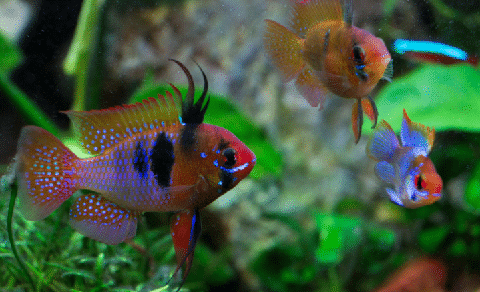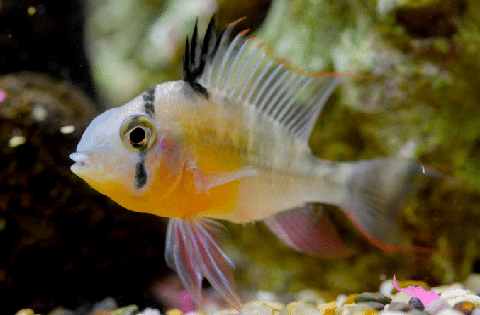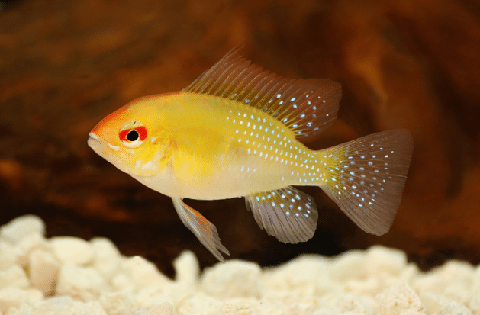Thank you for visiting! By the way… any links on this page that lead to products on Amazon and other stores/partners are affiliate links Aquarium Store Depot earns a commission if you make a purchase.
If you are looking for a cute, vibrant, and tranquil freshwater fish species, then take a look at the Ram cichlid.
The Ram or dwarf Cichlid is a stunning and tranquil freshwater fish species that have been observed for over 30 years. They go by many names, Ramirez’s dwarf cichlid, Blue ram, Butterfly ram, Ram ramirezi, and Dwarf cichlid. All these names lead to one beautiful fish species, belonging to the family Cichlidae and originating in South America, mostly in Amazon and Orinoco river extensions.
Dwarf cichlids are divided into many types based on their coloration and physical appearance that selective and captive breeding has developed.
Brief Overview of the Ram Cichlid
| Scientific Name | Mikrogeophagus ramirezi |
| Common Names | Ram Cichlid, blue ram, German blue ram, Asian ram, butterfly cichlid, Ramirez’s dwarf cichlid, dwarf butterfly cichlid, and Ramirezi |
| Family | Cichlidae |
| Origin | South America |
| Diet | Omnivore |
| Care Level | Moderate-Advanced |
| Activity | Moderate |
| Lifespan | 3 – 4 years |
| Temperament | Peaceful |
| Tank Level | Mid to bottom |
| Minimum Tank Size | 30 gallons |
| Temperature Range | 75 ° to 82 °F |
| Water Hardness | 6-14 d GH |
| pH Range | 5.0 to 7.5 |
| Filtration/Water Flow | Low |
| Water Type | Freshwater |
| Breeding | Egg layer |
| Difficulty to Breed | Easy |
| Compatibility | Community tanks |
| OK, for Planted Tanks? | Yes |
Ram Cichlids Appearance

Ram cichlid are small dwarf cichlids with large fins that overshadow their oval-shaped bodies.
Ram cichlid has vibrant reddish-orange, red and yellow spots all over their body with bright red eyes and a black band running through them. Due to their unique coloration and outstanding patterns, they make a great addition to your community aquarium.
In ram cichlids, the male rams are larger in length and possess the biggest dorsal fin. Because of their flowy dorsal fins and colorful appearance, they are commonly called butterfly cichlids.
How Big Are They?
Ram cichlids fall under the dwarf cichlids category. Therefore, they can never grow larger than 2-3 inches in captivity. However, in the wild, Ram cichlids are known to reach a maximum of 7 to 8 inches in length.
How Long Do They Live?
In captivity, the ram cichlid lives for up to 4 or 5 years. Even though hardy creatures, ram cichlids demand extreme care and a properly cleaned tank. Otherwise, they can develop deadly diseases such as fish tuberculosis. If ram cichlids are not provided with ample care and maintenance, they can also die of stress.
The lifespan of Ram cichlids depends on many factors such as water quality, diet, water parameters and temperature, pH and water hardness, and above all, the overall health.
Temperament and Activity Level
Ram cichlids are community tank fish with a peaceful nature. However, some types such as Bolivian rams can get semi-aggressive and territorial, when they feel their territories are being invaded.
Ram cichlids are average swimmers and quick at hiding in their favorite spots to catch prey to eat. Therefore, an aquarium should be well-planted with lots of aquatic plants and hiding places such as driftwood, caves, rocks, etc.
Tank Mates
No matter how agile and peaceful Ram cichlids are, you cannot keep them with any other fish. Here are the 15 most suitable tank mates for your ram cichlid.
- Guppies
- Platies
- Mollies
- Swordtails
- Dwarf Gourami
- Bristlenose Pleco
- Cory catfish
- Kuhli Loach
- Tetras
- Zebra Danio
- Discus fish
- Angelfish
- Rasboras
- Oto catfish
- Black ghost knife fish
Aquarium Requirements
Ram cichlids are very particular about their living environment. If the fish tank doesn’t meet all the requirements, ram cichlid can go into stress and eventually die. Therefore, it is imperative to take preventive measures and provide them with optimal conditions.
Tank Size
Even though ram cichlids are dwarf cichlids, they require plenty of swimming space. Therefore, go for a tank that is at least 20 gallons or more. It also depends on the number of fish you want to keep. If you’re aiming for more than one male, opt for a 29-gallon tank. One other reason to keep them in a large aquarium is they are highly sensitive to nitrates and prefer a gentle flow. So, more water and a larger tank ensure the maximum health of your rams.
UNS offers a quality rimless aquarium at a great price. One of the big pure rimless aquarium brands you can purchase today!
Not just that, they appreciate regular water changes, and so I recommend installing a premium quality canister filter to raise a healthy ram cichlid.
Water Parameters
One thing I can safely say about these cichlids is they don’t need a chiller, but a heater would suffice their needs.
Ram cichlids are tropical fish that thrive in warm water temperatures of around 78 to 85 °F. Therefore, I recommend installing a high-quality heater to provide them with the optimal temperature. Also, your rams will live happily if you create a natural environment for them. For this, fish experts suggest putting a fine substrate and plenty of plants with lots of hiding places in the form of rocks and caves for hiding or breeding.
Tank Setup
A ram cichlid is very susceptible to certain chemicals and rapid changes in its environment. All these rapid changes and traces of chemicals can cause piscine (fish tuberculosis) which is fatal and inevitable if water quality is ignored.
As far as the lighting is concerned, a ram cichlid prefers dim lights. If you have plants, I recommend using adjustable LED lights, low light plants, or getting floating plants to provide them with suitable shade without affecting your plants.
Since ram cichlid are sensitive, make sure to check the levels of ammonia and nitrates in their tank and change the water weekly to ensure quality.
Breeding
To ensure the successful breeding of ram cichlid in their breeding season, make sure to provide soft water conditions by adding a small bag of rinsed peat to your canister filter. Also, make sure to keep the water pH neutral within recommended temperature range as ideal water conditions increase their activity level and improve the chances of breeding.
In the natural habitat, a ram cichlid is a known open spawner, which means they create family groups and lay around 150 to 200 eggs approx.
Adult rams are difficult to pair with and costly as well. The cheaper and more effective way is to get juveniles and let them grow and pair together. Since they are monogamous pairs, I recommend keeping the breeding pair in a separate breeding tank for spawning.
Additionally, make sure to keep the water warmer in the breeding tank by around 2 to 3°F and more acidic with a slow water flow.
You can also feed the breeding pair with live food, such as blood worms, white worms, and brine shrimp as a treat once a day.
The Birth Process
Before keeping ram or dwarf cichlid, be informed that they do not lay eggs at all, if they are stressed during breeding. Rams only lay eggs when they are relaxed and devoid of other distractions. When their females are pregnant, their pink bellies become visibly fat and a female blue ram cichlid lay eggs under large, flat rocks and demands complete solitude. Hence, it is recommended to keep the pregnant female in a separate tank, no matter how peaceful they are.
Your tank setup and parameters should also be adjusted according to the liking of your breeding pair. The water should be of a neutral pH to slightly higher for optimal breeding and the temperature should be raised than the usual temperature which is around 77°F and 82°F. The warmer temperatures increase activity and improve the chances of successful breeding.
In cichlids, both mother and father fish raise the fry, which is unique for freshwater fish species. The fry rests in father ram’s mouth if they sense any potential danger and you should pay special attention to the fry because they can be swept into the filter.
What do They Eat?
Feeding rams with high-quality food that is rich in protein is quintessential for successful breeding and raising healthy, happy rams.
Since ram cichlid is omnivorous, it relies on plants and meat. In their natural habitat, they feed on floating plants and small insects, larvae, and other invertebrates.
However, seasoned aquarists recommend feeding them brine shrimp, earthworms, artemia, blood worms, tubifex, white worms, and cyclopeeze. But bear in mind that the live food should be free of contaminants like bacteria, fungus, etc to avoid diseases and other health-related issues.
I don’t recommend pellets and flakes on a daily. However, if you’re feeding them commercial food, make sure it sinks as butterfly cichlids are not surface dwellers. Also, incorporate plants and vegetables in their diet and feed them two to five small portions of meals several times a week. This also helps preserve the quality of water.
If your butterfly cichlid is new to the tank, it will be timid at the feeding time and may completely refuse to eat as they settle in its new fish tank. To cater to this, isolate the fish and feed them with treats such as mosquito larvae and start establishing their regular diet.
Diseases
Like most fish, rams are also vulnerable to tropical fish diseases, especially to poor water quality and stress that weakens their immune system.
One common disease in ram cichlids is ich, which is usually treated by increasing the water temperature to 86ºF for three days.
The butterfly cichlids are also susceptible to:
- Parasitic infestations
- Bacterial infections
- Fungal infections
- Tuberculosis
- In addition to these, these fish species can also develop Costia diseases, flatworm, and tapeworm infestations.
Different Types
Among the plethora of strains of Ram cichlids, there are four common types that aquarists love.
German Blue Rams
German blue ram cichlids are very popular among the aquarists because they are not only beautiful but docile and peaceful community tank fish. Like other ram cichlids, German blue rams are bred in captivity and are small fish around 2.5 inches with a calm personality.
German blue rams originate from the river basins of Orinoco, in the savannas of Venezuela, Colorado, and South America. The main body of a German blue ram cichlid is divided into three prominent colors mainly orange, gold, and turquoise blue. Additionally, there’s a black striped line on their face that covers their vivid orange eyes. The fins of German blue rams have blue mottling and a black dot on their midriff.
German blue rams live with other community tank fishes peacefully. However, they are territorial and aggressive fish, especially when other fish try to invade their territories. However, German blue rams are known to be good parents that do not abandon their fry hatch.
Bolivian

Bolivian Ram cichlids are the largest of all ram cichlids that can reach up to inches in length. They are also available in the wild.
They originate from the Amazon river basins, especially in Brazil and Bolivia. Hence, the name. They are found in slow-moving streams, rivers, lakes, and pools with densely populated vegetation that protects them from predators and provides them with food.
Bolivian rams demand larger tanks of no less than 30 gallons and the tank size is crucial to the health of this fish. They also love densely planted aquariums with an appropriate substrate so they can continue their regular foraging activities.
The bodies of Bolivian ram cichlids have a simple base, mainly yellow or golden. However, the most prominent feature of these ram cichlids is the red highlights along with their fins. Due to this, they are also known as the red ram cichlid.
Bolivian rams are popularly known for their sifting behavior as they love sifting through the substrate for food. The recommended diet of these ram cichlids should contain pellets, flakes, chopped brine shrimp, blood worms, earthworms, and other protein content. Seasoned aquarists discourage feeding them live food as it might contaminate the water and spread fatal infections.
Fun Fact: The scientific name of Bolivian Ram Cichlid is not Mikrogeophagus ramirezi, as it is a different species, known as Mikrogeophagus altispinosus.
Golden Ram Cichlids

Like German blue ram, gold rams are also dwarf cichlids that reach a maximum of 2.5 inches overall with a light golden body and electric blue mottling on the fin. The dorsal fin of gold rams is spiky and they have pale eyes with a black pupil. Out of the four ram cichlids, golden rams are the lesser known and like Bolivian Rams, they are also found in a natural habitat.
The Golden Ram cichlid originates from the Rio Orinoco drainage within Venezuela and Colombia and they are usually found in pairs.
Like most cichlid species, the golden ram is a wonderful, colorful, and peaceful fish that is suitable for a community aquarium. However, it can become territorial sometimes. They require a lot of swimming space in a fish tank with ample plantations and hiding places. They are omnivorous, so should be fed a decent diet balanced with protein and occasional treats of live food.
Electric Blue
Electric blue rams (video source) are so much like their wild-caught cousins, but the differences lie in their coloration. The electric blue ram cichlids are radiant-blue in color with red patches around their body. Their eyes are orangish yellow along the forehead and that’s the most beautiful feature of electric blue rams.
The electric blue ram cichlids are popular in the aquarium trade since 2009 with their ovoid body and long spiky fins like blue rams. Unlike other dwarf cichlids, the electric blue rams are not suitable for beginners as they are more sensitive than other cichlid species.
Also, an electric blue ram is a very shy fish that hides in caves, rocks, or other hiding places when they feel bullied or threatened.
3 Main Sources
If you want a Ram fish for your aquarium, you can source it from:
- Local breeders or tradeshows
- Overseas fish farms
- Domestic fish farms (from your own country; typically from Florida)
There are many fish stores that sell Ram cichlid. However, these cichlids will most likely be imported from overseas. Imported cichlids might appear brighter with longer fins, but sometimes, they are artificially boosted by several hormones to enhance their vibrancy and overall appearance. However, the use of such hormones may adversely affect the life span of your cichlids.
If you wish to get a Ram Cichlid from domestic farms, be informed that they are mostly bred in Florida. It is better to get your Ram cichlids from domestic farms than an overseas farm, as they are in a much better condition.
But I recommend getting your aquarium buddies from a local breeder since they are kept in water conditions and environments similar to yours. Hence, they live and thrive in your home aquariums.
How to Pick a Healthy Fish?
So, you’ve made a decision to bring home a Ram cichlid? Great. But you should know how to pick a healthy one to avoid hazards.
- Select a healthy-looking, active ram cichlid that eats and swims well
- Pick the ones that compete with other rams for a great spawning site
- Avoid choosing skinny or shrunken rams with a hollow belly
If you’re looking for a breeding pair, aquarium breeders suggest getting a colorful make with extended dorsal fins and great pectoral fins. And if you find the female already paired with the male ram cichlid, get them; as there are higher chances of successful breeding.
How to Distinguish between Male and Female?
To distinguish between a male and female ram cichlid, always remember:
- Females have tiny, bright blue dots inside their black spots on the sides of their bodies
- Males lack these dots on their black spots.
FAQs
How Many Should Be Kept Together?
Ram cichlids require a large tank for free swimming space, easy feeding, and successful breeding. Therefore, a pair of ram fish can be kept in a 20- gallon community tank or an in a 10- gallon breeding rank with no other tank mates.
You can add multiple rams in a community tank but you have to increase the aquarium size according to the number of pairs. For example, a 40-gallon tank should accommodate 2 pairs of rams.
What Do They Eat?
Blue rams are omnivorous so they prefer a mix of both; leafy plant and meaty proteins. Seasoned aquarists recommend feeding them brine shrimp, earthworms, artemia, blood worms, tubifex, white worms, and cyclopeeze. But bear in mind that the live food should be free of contaminants like bacteria, fungus, etc to avoid diseases and other health-related issues.
Can I Keep A Single One?
Rams are community tank fish and thrive well with other like-minded tank mates, but you can keep a single ram cichlid as long as you provide them with ample space, nutritious food, and lots of hiding places to forage and play.
How Big Do They Get?
Ram cichlids fall under the dwarf category so they don’t get beyond 2-3 inches in captivity.
Can You Mix Them Together?
Yes, you can. However, please understand the needs of different cichlid types before mixing them together. Rams prefer warmer water temperatures that don’t go well with other fish. Also, choose a larger community tank of over 40 gallons to house multiple rams together.
How Long Do T hey live?
In captivity, the ram cichlid lives for up to 4 or 5 years. However, the lifespan of German blue rams highly depends on various factors, such as water quality, diet, water parameters and temperature, pH and water hardness, and above all, overall health.
Final Thoughts
Ram cichlids are very small fish around 2-3 inches in length. Despite their size, they require immaculate attention and care. Therefore, make sure to provide at least 20 gallons tank with lots of hiding places and aquatic plants to raise healthy and happy rams.
- About the Author
- Latest Posts
I’m thrilled that you found Aquarium Store Depot! Here you’ll find information on fish, aquariums, and all things aquatics related. I’m a hobbyist (being doing this since I was 11) and here to help other hobbyists thrive with their aquariums! I adhere to a high quality Editorial Process and Review products with real life field usage and practical analysis.






